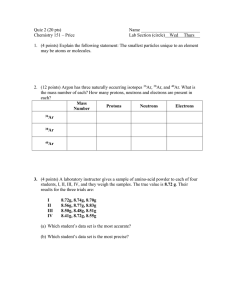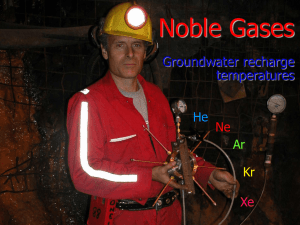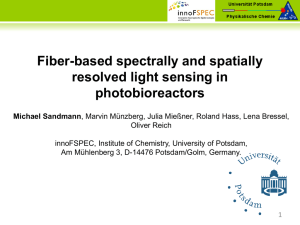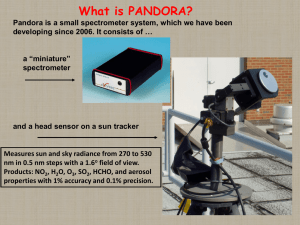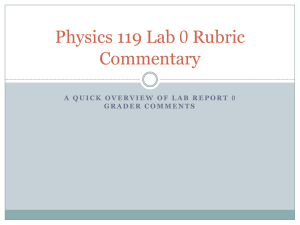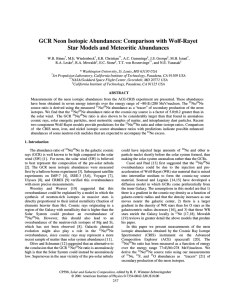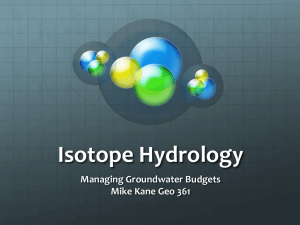Ne-Ar-Isotopic-Analy..
advertisement
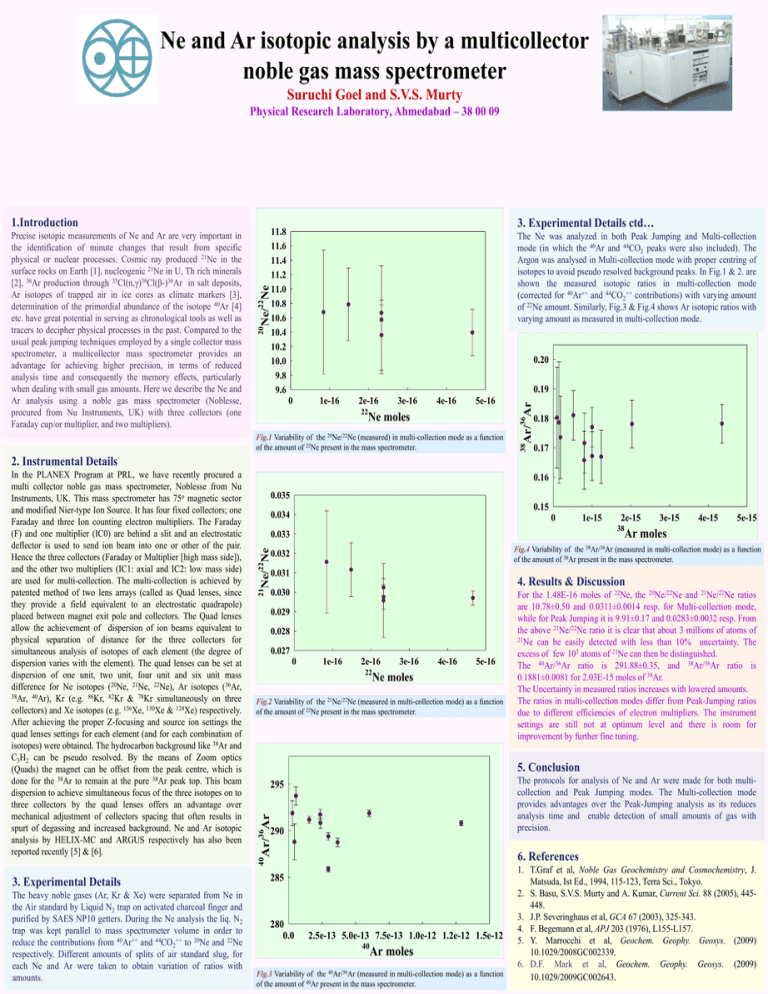
Ne and Ar isotopic analysis by a multicollector noble gas mass spectrometer Suruchi Goel and S.V.S. Murty Physical Research Laboratory, Ahmedabad – 38 00 09 3. Experimental Details ctd… 11.8 11.6 11.4 11.2 11.0 10.8 10.6 10.4 10.2 10.0 9.8 9.6 The Ne was analyzed in both Peak Jumping and Multi-collection mode (in which the 40Ar and 44CO2 peaks were also included). The Argon was analysed in Multi-collection mode with proper centring of isotopes to avoid pseudo resolved background peaks. In Fig.1 & 2. are shown the measured isotopic ratios in multi-collection mode (corrected for 40Ar++ and 44CO2++ contributions) with varying amount of 22Ne amount. Similarly, Fig.3 & Fig.4 shows Ar isotopic ratios with varying amount as measured in multi-collection mode. 0.20 1e-16 2e-16 22 3e-16 4e-16 5e-16 Ne moles Fig.1 Variability of the 20Ne/22Ne (measured) in multi-collection mode as a function of the amount of 22Ne present in the mass spectrometer. 36 0 Ar/ Ar 0.19 0.18 38 22 20 Precise isotopic measurements of Ne and Ar are very important in the identification of minute changes that result from specific physical or nuclear processes. Cosmic ray produced 21Ne in the surface rocks on Earth [1], nucleogenic 21Ne in U, Th rich minerals [2], 36Ar production through 35Cl(n,γ)36Cl(β-)36Ar in salt deposits, Ar isotopes of trapped air in ice cores as climate markers [3], determination of the primordial abundance of the isotope 40Ar [4] etc. have great potential in serving as chronological tools as well as tracers to decipher physical processes in the past. Compared to the usual peak jumping techniques employed by a single collector mass spectrometer, a multicollector mass spectrometer provides an advantage for achieving higher precision, in terms of reduced analysis time and consequently the memory effects, particularly when dealing with small gas amounts. Here we describe the Ne and Ar analysis using a noble gas mass spectrometer (Noblesse, procured from Nu Instruments, UK) with three collectors (one Faraday cup/or multiplier, and two multipliers). Ne/ Ne 1.Introduction 0.17 2. Instrumental Details 0.16 0.035 0.15 0.034 0 3. Experimental Details The heavy noble gases (Ar, Kr & Xe) were separated from Ne in the Air standard by Liquid N2 trap on activated charcoal finger and purified by SAES NP10 getters. During the Ne analysis the liq. N2 trap was kept parallel to mass spectrometer volume in order to reduce the contributions from 40Ar++ and 44CO2++ to 20Ne and 22Ne respectively. Different amounts of splits of air standard slug, for each Ne and Ar were taken to obtain variation of ratios with amounts. 22 Ne/ Ne 0.033 21 1e-15 2e-15 38 3e-15 4e-15 5e-15 Ar moles Fig.4 Variability of the 38Ar/36Ar (measured in multi-collection mode) as a function of the amount of 38Ar present in the mass spectrometer. 0.032 0.031 4. Results & Discussion 0.030 0.029 0.028 0.027 0 1e-16 2e-16 22 3e-16 4e-16 5e-16 Ne moles Fig.2 Variability of the 21Ne/22Ne (measured in multi-collection mode) as a function of the amount of 22Ne present in the mass spectrometer. For the 1.48E-16 moles of 22Ne, the 20Ne/22Ne and 21Ne/22Ne ratios are 10.78±0.50 and 0.0311±0.0014 resp. for Multi-collection mode, while for Peak Jumping it is 9.91±0.17 and 0.0283±0.0032 resp. From the above 21Ne/22Ne ratio it is clear that about 3 millions of atoms of 21Ne can be easily detected with less than 10% uncertainty. The excess of few 105 atoms of 21Ne can then be distinguished. The 40Ar/36Ar ratio is 291.88±0.35, and 38Ar/36Ar ratio is 0.1881±0.0081 for 2.03E-15 moles of 38Ar. The Uncertainty in measured ratios increases with lowered amounts. The ratios in multi-collection modes differ from Peak-Jumping ratios due to different efficiencies of electron multipliers. The instrument settings are still not at optimum level and there is room for improvement by further fine tuning. 5. Conclusion The protocols for analysis of Ne and Ar were made for both multicollection and Peak Jumping modes. The Multi-collection mode provides advantages over the Peak-Jumping analysis as its reduces analysis time and enable detection of small amounts of gas with precision. 36 Ar/ Ar 295 290 6. References 40 In the PLANEX Program at PRL, we have recently procured a multi collector noble gas mass spectrometer, Noblesse from Nu Instruments, UK. This mass spectrometer has 75o magnetic sector and modified Nier-type Ion Source. It has four fixed collectors; one Faraday and three Ion counting electron multipliers. The Faraday (F) and one multiplier (IC0) are behind a slit and an electrostatic deflector is used to send ion beam into one or other of the pair. Hence the three collectors (Faraday or Multiplier [high mass side]), and the other two multipliers (IC1: axial and IC2: low mass side) are used for multi-collection. The multi-collection is achieved by patented method of two lens arrays (called as Quad lenses, since they provide a field equivalent to an electrostatic quadrapole) placed between magnet exit pole and collectors. The Quad lenses allow the achievement of dispersion of ion beams equivalent to physical separation of distance for the three collectors for simultaneous analysis of isotopes of each element (the degree of dispersion varies with the element). The quad lenses can be set at dispersion of one unit, two unit, four unit and six unit mass difference for Ne isotopes (20Ne, 21Ne, 22Ne), Ar isotopes (36Ar, 38Ar, 40Ar), Kr (e.g. 86Kr, 82Kr & 78Kr simultaneously on three collectors) and Xe isotopes (e.g. 136Xe, 130Xe & 124Xe) respectively. After achieving the proper Z-focusing and source ion settings the quad lenses settings for each element (and for each combination of isotopes) were obtained. The hydrocarbon background like 38Ar and C3H2 can be pseudo resolved. By the means of Zoom optics (Quads) the magnet can be offset from the peak centre, which is done for the 38Ar to remain at the pure 38Ar peak top. This beam dispersion to achieve simultaneous focus of the three isotopes on to three collectors by the quad lenses offers an advantage over mechanical adjustment of collectors spacing that often results in spurt of degassing and increased background. Ne and Ar isotopic analysis by HELIX-MC and ARGUS respectively has also been reported recently [5] & [6]. 285 280 0.0 2.5e-13 5.0e-13 7.5e-13 1.0e-12 1.2e-12 1.5e-12 40 Ar moles Fig.3 Variability of the 40Ar/36Ar (measured in multi-collection mode) as a function of the amount of 40Ar present in the mass spectrometer. 1. T.Graf et al, Noble Gas Geochemistry and Cosmochemistry, J. Matsuda, Ist Ed., 1994, 115-123, Terra Sci., Tokyo. 2. S. Basu, S.V.S. Murty and A. Kumar, Current Sci. 88 (2005), 445448. 3. J.P. Severinghaus et al, GCA 67 (2003), 325-343. 4. F. Begemann et al, APJ 203 (1976), L155-L157. 5. Y. Marrocchi et al, Geochem. Geophy. Geosys. (2009) 10.1029/2008GC002339. 6. D.F. Mark et al, Geochem. Geophy. Geosys. (2009) 10.1029/2009GC002643.
